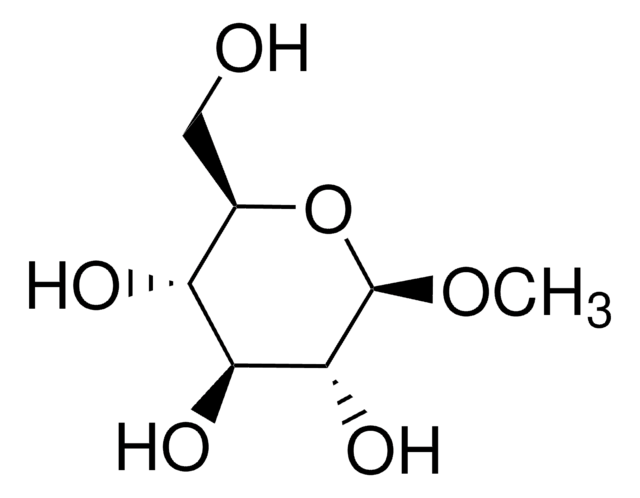66940
Methyl α-D-Glucopyranosid
≥99.0%, suitable for microbiology
Synonym(e):
Methyl-α-D-glucosid
About This Item
Empfohlene Produkte
Qualitätsniveau
Assay
≥99.0% (sum of enantiomers, HPLC)
≥99.0%
Form
crystalline powder
Optische Aktivität
[α]20/D +157±3°, c = 10% in H2O
Verpackung
pkg of 100 g
Lagerbedingungen
(Keep container tightly closed in a dry and well-ventilated place.)
Farbe
colorless
mp (Schmelzpunkt)
165-169 °C
Anwendung(en)
microbiology
SMILES String
CO[C@H]1O[C@H](CO)[C@@H](O)[C@H](O)[C@H]1O
InChI
1S/C7H14O6/c1-12-7-6(11)5(10)4(9)3(2-8)13-7/h3-11H,2H2,1H3/t3-,4-,5+,6-,7+/m1/s1
InChIKey
HOVAGTYPODGVJG-ZFYZTMLRSA-N
Suchen Sie nach ähnlichen Produkten? Aufrufen Leitfaden zum Produktvergleich
Verwandte Kategorien
Allgemeine Beschreibung
Anwendung
Lagerklassenschlüssel
11 - Combustible Solids
WGK
WGK 1
Flammpunkt (°F)
Not applicable
Flammpunkt (°C)
Not applicable
Persönliche Schutzausrüstung
Eyeshields, Gloves, type N95 (US)
Choose from one of the most recent versions:
Besitzen Sie dieses Produkt bereits?
In der Dokumentenbibliothek finden Sie die Dokumentation zu den Produkten, die Sie kürzlich erworben haben.
Kunden haben sich ebenfalls angesehen
Artikel
Culture media provides a habitat with suitable nutrients, energy sources, and certain environmental conditions for the growth of microorganisms. The components of the culture media range from simple sugars to peptones, salts, antibiotics, and complex indicators.
Unser Team von Wissenschaftlern verfügt über Erfahrung in allen Forschungsbereichen einschließlich Life Science, Materialwissenschaften, chemischer Synthese, Chromatographie, Analytik und vielen mehr..
Setzen Sie sich mit dem technischen Dienst in Verbindung.








